





Disclaimer: Copyright infringement not intended.
Context
INS Vikrant
|
STOBAR Vs CATOBAR Type of Carriers These two are basically the assistance systems for an aircraft to take off from a carrier. Basically, the runway on the carrier deck is very small compared to the ground-based runways. Thus, aircraft can’t take off using only the thrust produced by their own engines. They need extra help to get airborne from such a short runway. This help is us provided by STOBAR and CATOBAR systems. STOBAR Type of Aircraft Carriers STOBAR stands for Short Take-off but Arrested Recovery (B stands for Barrier also). In this type of carrier, the frontal part of the deck is elevated forming a curve. This is called the ‘Ski-jump’. Thus, when an aircraft leaves the deck at the end of the runway, it doesn’t travel straight in the same plane. Instead, it is thrown upward due to this curve. This helps aircraft in gaining height during the initial period. In the meantime, aircraft engines with afterburners start generating the required thrust and it gets stabilized in its flight. Here aircraft uses its own power to launch and is assisted by Ski-jump. Examples– Indian Navy’s carriers INS Viraat which are decommissioned now, INS Vikramaditya (currently operational), and upcoming INS Vikrant are of STOBAR type. Also, British Royal Navy’s HMS Queen Elizabeth, Russian aircraft carrier Admiral Kuznetsov, and Chinese Type 001 and Type 002 use the same system.
MiG-29K taking off from Ski-jump (STOBAR system) CATOBAR Type of Aircraft Carriers CATOBAR stands for Catapult Assisted Take-off But Arrested Recovery (B stands for Barrier also). In these systems, the deck of the carrier is totally flat. Thus, they are also called ‘Flat-topped’ Aircraft carriers. We know the working mechanism of Catapult. The energy is stored in it. When this energy is released, it gets covered in kinetic energy. Due to this, the object placed on the catapult is launched with speed. The same mechanism is applied to the Carriers.
Steam Catapult assisted launch Catapults are there under the deck. The frontal wheel of the aircraft is placed on the moving part of the catapult which is above the deck. Once the energy is released, it moves and achieves great speed in a short distance and time. Thus the Aircraft is launched from the deck with the required speed to get airborne. Two types of systems are used to power the catapults. One is Steam-powered catapults. Another is Electromagnetic Aircraft Launch System (EMALS). Examples– US Navy’s carriers like USS Nimitz, USS Ronald Reagan, etc and French carrier Charles de Gaulle.
What is Arrested Recovery? The runway on carriers is again too short for an aircraft to land. Thus, arrested recovery technique is used. The high-strength arrestor wires are placed on the deck. The aircraft has a tailhook under its fuselage. Thus tail hook gets arrested in one of the four wires on the deck. Due to this Aircraft is decelerated rapidly in a short distance. If the aircraft misses all the wires, then it takes off again instantly and reattempts the landing.
FA 18 Landing on Arrested Recovery System STOBAR Vs CATOBAR: A Comparison Advantages Of STOBAR System:
Disadvantages Of STOBAR System:
Advantages Of CATOBAR System:
Disadvantages Of CATOBAR system
Which system is used in Indian Aircraft Carriers? STOBAR Vs CATOBAR India till now has operated only STOBAR type of carriers. Current carrier INS Vikramaditya and upcoming INS Vikrant are also of the same type. But IAC-2 i.e., INS Vishal (planned) is likely to be a CATOBAR type of carrier. It may have Electromagnetic Aircraft Launch System (EMALS). |
|
PRACTICE QUESTION Q. Consider the following statements. a) INS Vikrant features a STOBAR (Short Take-off but Arrested Recovery) configuration. b) STOBAR System is less expensive for maintenance as there are no moving parts on the deck. c) STOBAR System cannot launch aircraft weighing beyond a certain limit. d) India until now has operated only STOBAR type of carriers. How many of the above statements are correct? (a) Only one (b) Only two (c) only three (d) All of the above. Correct Answer: (d) All of the above. |











© 2025 iasgyan. All right reserved